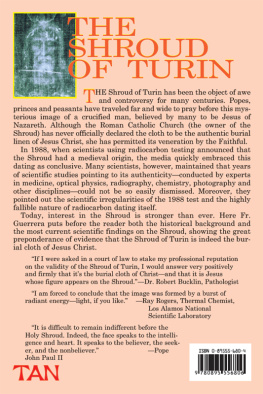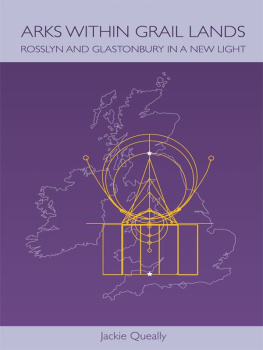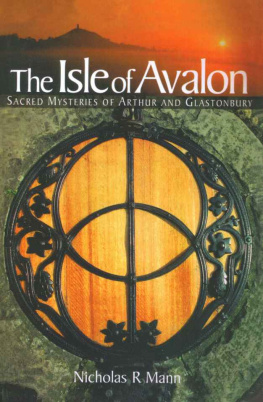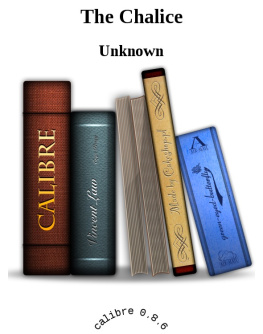CONTENTS
Joseph of Arimathea: Mystery Man of the Gospels (A Paper by Ed Prior)
Many of those who helped with the research of my previous book, The Knights Templar in Somerset, have again enthusiastically helped and supported me with the material for this book.
My special thanks go to retired NASA scientist and Shroud scholar Ed Prior, who I met when he visited England in 2010 to lecture about Joseph of Arimathea and the Turin Shroud. I did not feel that I had researched Joseph of Arimathea fully enough to deal at length with the vexed question, Did Joseph bring Christianity to England? Therefore, Ed has written a special paper to be included in this book on my behalf (see Appendix). Ed has been researching Joseph of Arimathea for many years, and is working on his own book about early Christianity. I am greatly honoured that he has taken the time and trouble to write for this book; for this I owe him a debt of gratitude.
Special thanks once again to Shroud researcher and international author Rex Morgan, with whom I have been comparing notes on the activities of the Knights Templar in England. Rex and I met last year on his visit to this country, and I am most grateful that he has made his early research available to me. One chapter of this book includes the fascinating research that he and his team conducted in the 1980s concerning the Templecombe Panel.
Thank you once again to Barbara Birchwood Harper and Daniel Agee of the Looe Old Cornwall Society, who gave me some enlightening information on the connections between Looe Island and Glastonbury Abbey. Daniel has written several very interesting essays on the Cornwall/Glastonbury connection.
Thank you also to Paul Ashdown, whose own research work in some ways touches on my own, and has provided some interesting insights.
Many thanks to my friend and neighbour Becky, for her delightful illustrations. Also to Ken Macfarlane for freely giving his time to take photographs for the book, not to forget Elizabeth Blaymires, who popped through my letterbox an old folk poem recited to her by her grandmother when she was a child in 1948, entitled The Son of Man on Mendip.
Others who have assisted either directly or indirectly are: Kevin Spears, Wells Cathedral Librarian; Tom Bree; Susan Hannis; Clive Wilkins; Dr Simon Johnson; Dr Harvey Thompson; the staff at Glastonbury Abbey; the staff at Winchester Cathedral, and the Hospital of St Cross; the staff at Looe Museum and Glastonbury Abbey.
Also, my thanks to all those who have offered time and support in many other ways during the writing of this book.
Last but not least my special thanks to Fi Bannister, who has walked the sacred places with me, and encouraged and supported me in many ways over the past few years; Harvey Thompson, who is on the path; and my sons Tristan and Tobias, who have shared all the highs and lows that my research entails!
Since time immemorial, Glastonbury has acted as a magnet for pilgrims, saints, sinners and tourists alike. It appears that many are drawn to the place for some reason unknown to themselves. Many, if not most, are seeking something, but what? Perhaps they seek to find or understand the elusive Grail?
Here at Glastonbury we find stories that tell of Joseph of Arimathea visiting Somerset as a tin merchant, accompanied by the boy Jesus; legends of King Arthur; whispers of a faery realm within the Tor; and the ruins of what was arguably once the greatest abbey in England. There are tantalising tales of the cup of the Last Supper, hidden in the Chalice Well, and whispers of fragments of the shroud of Christ once venerated at a Perilis Chapel.
In researching this book, I wanted to explore whether there was any truth behind these tales: were they mere fabrication, or could it be that once, long ago, someone or something of unique and sacred importance arrived in England and found its way to Somerset?
Since writing my previous book, The Knights Templar in Somerset, I found I was certainly not alone in my beliefs others had been thinking in a similar way, and several have contacted me to tell me about their own research and ideas. As a consequence of this, I have been fortunate enough to meet and spend time with both Shroud scholar and international author Rex Morgan, and Ed Prior, retired NASA scientist and Shroud scholar. Rex has shared his research on the Templecombe Panel with me, while Ed has imparted his knowledge of Joseph of Arimathea in a special appendix section of the book.

The Somerset Tradition, Glastonbury Abbey. (Courtesy of Ken Macfarlane)
Their ideas reinforced my own conviction that there could indeed be a connection between the mysterious legends of the Holy Grail and the relic known as the Holy Shroud of Turin, and these grail legends led to the heart of my home county, Somerset, and most especially to Glastonbury.
Perhaps the legends and folk memories which have been passed down to us through the ages are more than just stories; within them we may find an ancient memory of a much greater, more mysterious and inspirational truth
Juliet Faith, 2012
THE SON OF MAN
ON MENDIP
(An Old Somerset Poem)
The Son of Man on Mendip
He walked among the fern
Against the blackness of the down
He saw the heather turn.
The Son of Man on Mendip
Gazed down the glistening tide
Beyond the sprinkled Islands
Where the grey lagoons spread wide.
For Joseph was a tinman
Who sailed the Western sea
And brought his young companion
Across to Eggarley.
Where amid the golden orchards
Whose scent the silence thrills
The Lamb of God in beauty trod
Our Avalonian hills.
The Son of Man on Mendip
He gave the folk no sign,
But talked and walked with such as worked
The led and coalmine.
He knew the old Nine Barrows,
The swallets and the droves,
As well as, on far southern slopes,
He knew the orange groves.
As summer passed to autumn,
He marked the changing days.
The blood red wicken berries
In Ebbor Gorge ablaze.
The crocus in the meadows,
The gold upon the wheat,
And snow-white bog cotton
Bent to those gentle feet.
The Son of Man on Mendip
He breathed the common air
And so folk tell by word of mouth,
He played at Priddy Fair.
For Joseph was a tinman
Who dealt in dyes and ores.
Trading from torrid Nazareth
To Somersets green shores.
On Easter morning
When the clouds be rolled away,
And climbing Maesbury beacon
The young sun brings the day,
They that be simple hearted
That nothing ill have done,
A wondrous sign may witness
The Lamb against the sun.
THE SHROUD OF TURIN
THE TRUE BURIAL
SHROUD OF CHRIST?
Much of this book is concerned with a presumed burial linen or shroud of Jesus, and the importance that it had historically, and may still have for us today. I therefore decided that it was prudent to give a short synopsis of the only real contender for the title the true burial Shroud of Jesus; that is the cloth known today as the Shroud of Turin.
Sceptics delight in commenting that there were once many presumed Shrouds of Christ. Certainly during the sixteenth and seventeenth centuries there were known to be about fifty contenders for the shroud, some examples of which still survive to this day, such as the one displayed in the church of Notre Dame de Chambery, which is a watercolour on fabric.
The Lier Shroud, commissioned by a member of the Savoy family, is believed to have been be painted by Durer in 1516. As a historical record it is of great interest, but is clearly the work of an artist.










